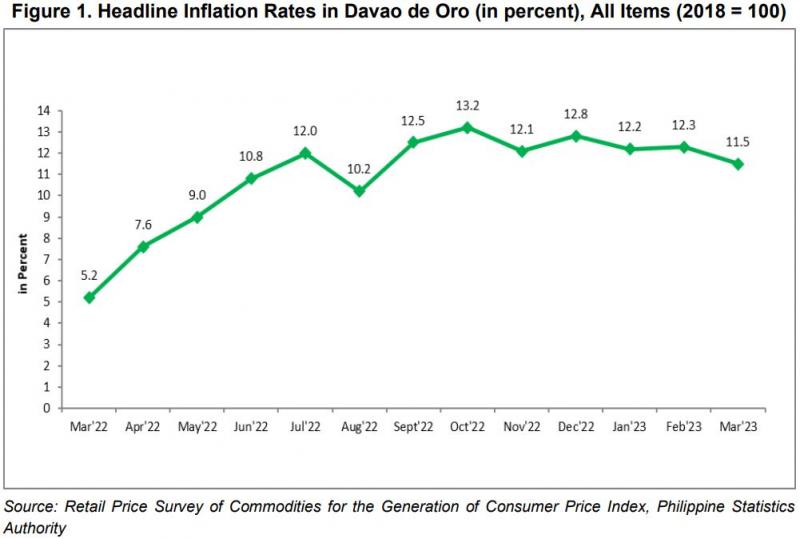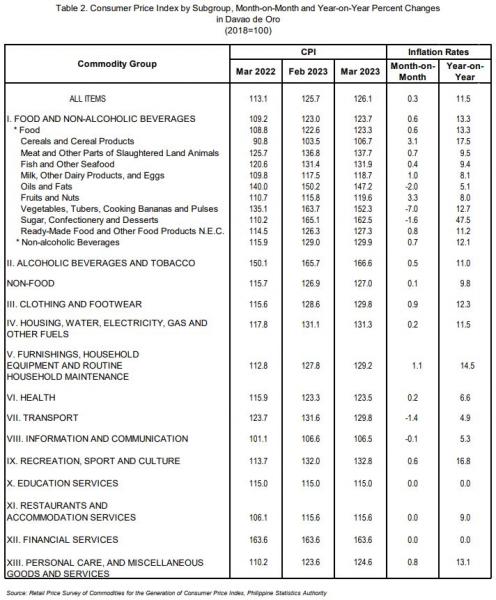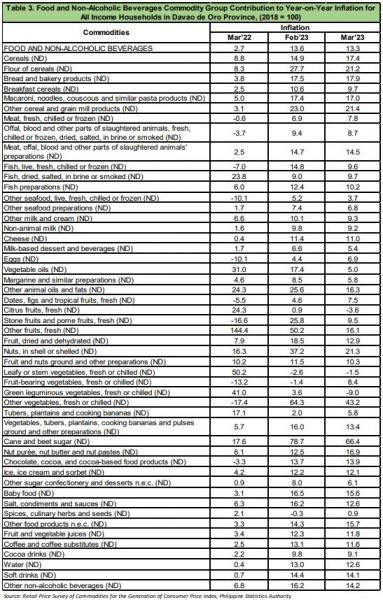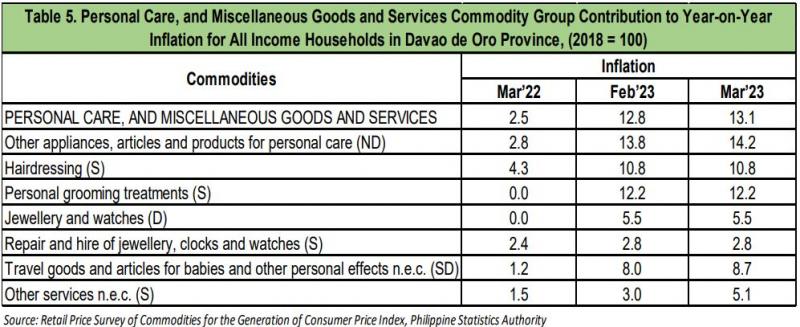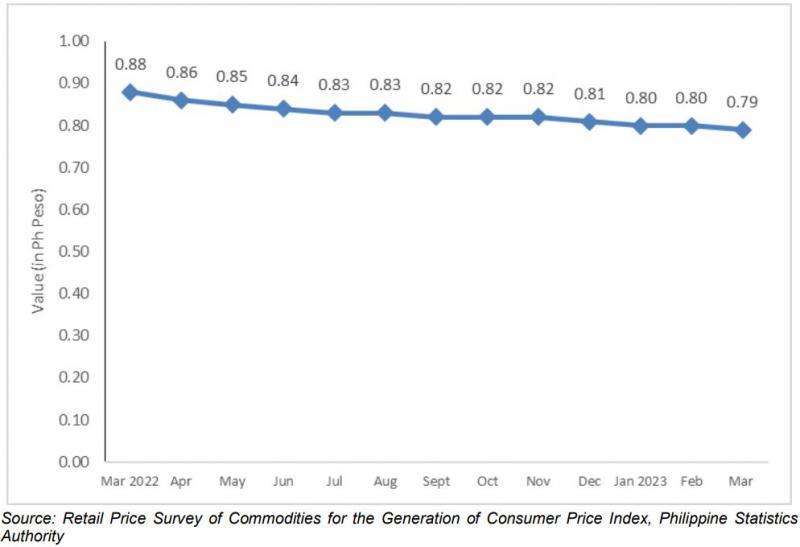The headline inflation of prices in Davao de Oro Province decreased to 11.5 percent in March 2023 from 12.3 percent in February 2023 or a decrease of 0.8 percentage point. Inflation of prices in March 2022 was lower at 5.2 percent. The average inflation for the year 2023 stood at 12.0 percent. (Table 1 and Figure 1)
The decline in the province’s inflation was mainly brought about by the downtrend annual rate in the index of Food and non-alcoholic beverages which declined to 13.3 percent from 13.6 percent in February 2023; and Housing, water, electricity, gas and other fuels at 11.5 percent from 12.2 percent in February 2023. On the other hand, Personal care, and miscellaneous goods and services also contributed to the overall inflation rate due to its commodity group weight even if its inflation rate inclined from 12.8 percent in February 2023 up to 13.1 percent in March 2023. (Table 2)
Also contributing to the downtrend in the overall inflation during the period were the annual price changes in the indices of the following commodity groups as compared with their previous month’s inflation rates:
Alcoholic, beverages and tobacco, 11.0 percent;
Transport, 4.9 percent;
Information and communication, 5.3 percent; and
Restaurants and accommodation services, 9.0 percent.
Clothing and footwear, Furnishings, household equipment and routine household maintenance, Health, and Recreation, sport and culture showed an uptrend rate in the overall inflation at 12.3 percent, 14.5 percent, 6.6 percent and 16.8 percent, respectively. Education services and Financial services remain no price changes since July 2020 and April 2022.
Food and non-alcoholic beverages group shared the highest contribution for the month’s inflation rate at 6.7 points (58.0 percent). As to the percent share to the month’s downtrend rate of the said commodity group, Fish, live, fresh, chilled or frozen posted the highest percent share at 34.9 percent, followed by Other vegetables, fresh or chilled at 26.3 percent, and Cane and beet sugar at 11.9 percent. (Table 3)
The second highest contributor for February 2023 inflation rate is the Housing, water, electricity, gas, and other fuels commodity group with a contribution of 2.0 points (17.6 percent) among all items. Under this group, Wood fuel, including pellets and briquettes posted the highest percent share to the inflation downtrend at 42.7 percent, followed by Liquefied hydrocarbons at 40.8 percent, and Liquid fuels with a percent share of 13.1 percent. (Table 4)
Personal care, and miscellaneous goods and services commodity group ranked third with a contribution of 0.6 point (5.0 percent). Under this group, Other appliances, articles and products for personal care posted the highest percent share to the inflation uptrend at 80.5 percent, followed by Travel goods and articles for babies and other personal effects with a percent share of 16.3 percent, and Other services at 3.2 percent. (Table 5)
Below is the inflation rates trend of Davao de Oro Province since the rebasing of market basket with year 2018 as the base year. (Table 6)
Consequently, the Purchasing Power of Peso (PPP) based on year 2018 in Davao de Oro Province is equivalent to 0.79 in March 2023. (Figure 2)
Figure 2. Purchasing Power of Peso in Davao de Oro (2018 = 100)
March 2022 – March 2023
Technical Notes:
Price – is the amount or value paid in exchange for the commodity or a service rendered.
Retail/Consumer Price – refers to the price at which a commodity is sold in small quantities for consumption.
Market Basket– a term used to refer to a sample of goods and services that are commonly purchased and bought by an average Filipino household.
Consumer Price Index (CPI) – it is an indicator of the change in the average retail prices of a fixed basket of goods and services commonly purchased by an average Filipino household. It shows how much on the average, prices of goods and services have increased or decreased from a particular reference period known as base year.
Inflation Rate – is an indicator derived from the CPI. It refers to the annual rate of change or the year-on-year change of the CPI expressed in percent. Inflation is interpreted in terms of declining purchasing power of money.
Weight– a value attached to a commodity or group of commodities depending on the magnitude of its contribution to the index.
Base Period – a reference date at which the index is equal to 100. Base year is 2018.
Index Methodology– a Laspeyre’s formula: fixed base year and weights.
Purchasing Power of the Peso (PPP) – the measure of how much the peso in the base period is worth in the current period.
Percentage Change– is a simple mathematical concept that represents the degree of change over time. It is used for many purposes in finance, often to represent the price change of a security.
Headline Inflation– measures changes in the cost of living based on movements in the prices of a specified basket of major commodities. It refers to the annual rate of change or the year-on-year change in the Consumer Price Index (CPI).


